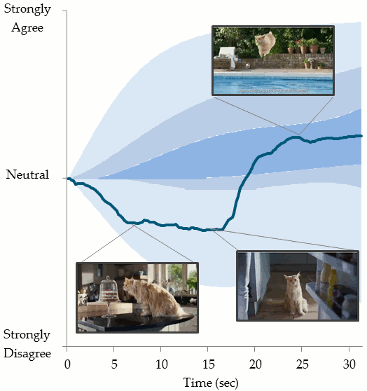When Should Ads Get Happy?
Posted: 09/01/2017

A previous post discussed why it’s important to measure the core emotion of an advert and how this is characterised by its arousal and valence (the latter being the happy-sad dimension). But how do adverts generate this overall impact and what is the relationship between how people feel during an advert and what they later recall feeling?
Memory is a fickle friend. Ask anyone in an exam hall. And apparently this frailty of recollection is a widely recognised phenomenon. The recall of even the most transfixed sports-watchers is deemed so precarious by broadcasters that they repeatedly feed viewers instant replays to remind them of a goal that they’ve just seen. Given that this isn’t really an option for advertisers, they need to work with the 30 seconds they have (or, indeed, with the 8 seconds of attention they get during those 30 seconds).
‘This is a Happy Advert…’

https://www.youtube.com/watch?v=-xa2IgYBnUQ
The graphic shows the valence timecourse for an O2 advert against a distribution of UK advertising norms. Before discussing the advert, two features of the norms are worth noting. First, the upward trend indicates that adverts typically try to be happy. Second, the downward skew (i.e. the wider band of light shading around ‘strongly disagree’) shows that there are some ads that actively aim for pathos, such as John Lewis, who are renowned for their ‘sadvertising’ at Christmas (e.g. Man On The Moon). This year, however, they went down the more conventional happy route featuring Buster the Boxer bouncing on a trampoline, but it failed to land the desired heart-warming effect when a parody likened the ad to the surprise Trump victory in the US elections.
Against the backdrop of these advertising norms, the O2 advert is interesting. Initially it’s a low valence outlier before reversing to finish at around average happiness. But, intriguingly, the retrospective ratings for this particular advert are happier still. In other words, it’s recalled as happier than the timeline average implies.
Daniel Kahneman, the Nobel laureate, highlighted the differences between what people experience and what they remember (2000). In one experiment (1996) he showed how colonoscopy patients retrospectively rated pain using a ‘peak-end’ rule. The total amount of pain wasn’t predictive. What mattered was the peak amount of pain and the pain experienced during the final stages of the procedure. Many who work in advertising will see the parallels with having a colonoscopy. The O2 advert is recalled as happy because it ends happily. But crucially this recall is amplified by the contrast with the earlier, sadder storyline. The emotional impact of an advert is not a linear function of its timecourse. It is the product of framing, peak-end effects and so forth.
Kahneman, D. & Tversky, A. (2000). Choices, Values, and Frames. Cambridge, UK: Cambridge University Press.
Redelmeier, D. A. & Kahneman, D. (1996). Patients’ memories of painful medical treatments. Pain, 66 (1), pp: 3-8